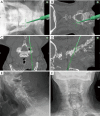MIS approaches in the cervical spine
- PMID: 31380495
- PMCID: PMC6626755
- DOI: 10.21037/jss.2019.04.21
MIS approaches in the cervical spine
Abstract
Minimally invasive surgical approaches for the treatment of spinal pathologies have accelerated over the past three decades and resulted in superior functional outcomes with less complications. Yet cervical pathologies have been slower to gain traction for multiple anatomical factors and its "high-risk" profile. Various minimally invasive techniques for cervical disease have now been described and validated in long-term studies with comparable outcomes to traditional open approaches and concomitant reduction in morbidity and socioeconomic costs. Transnasal operations can be used to treat ventral upper cervical disease, circumventing traditional and morbid transoral approaches. Posterior-based focused treatments for radiculopathy and myelopathy such as tubular-guided foraminotomies and unilateral laminotomies for bilateral cord decompression have also been described and becoming increasingly less invasive. Cervical fusions can now be performed percutaneously through modified, stand-alone facet joint cages that can be packed with allogeneic bone graft. These advances have been facilitated by the development of intraoperative imaging technologies (intraoperative CT) and 3-dimensional stereotactic navigation software. While this review focuses on these procedures and evidence-based outcomes data, the future for MIS applications in cervical spine surgery will continue to evolve over the coming years with wider indications and technological adjuncts.
Keywords: 3D; cervical; endonasal; endoscopic; facet cage; foraminotomy; fusion; interfacet; laminectomy; laminotomy; minimally invasive spine (MIS); navigation; odontoidectomy; over the top; posterior.
Conflict of interest statement
Conflicts of Interest: The authors have no conflicts of interest to declare.
Figures








References
Publication types
LinkOut - more resources
Full Text Sources
Miscellaneous
